Blue Jay: Field Guide, Pictures, Habitat & Info
Last Updated on
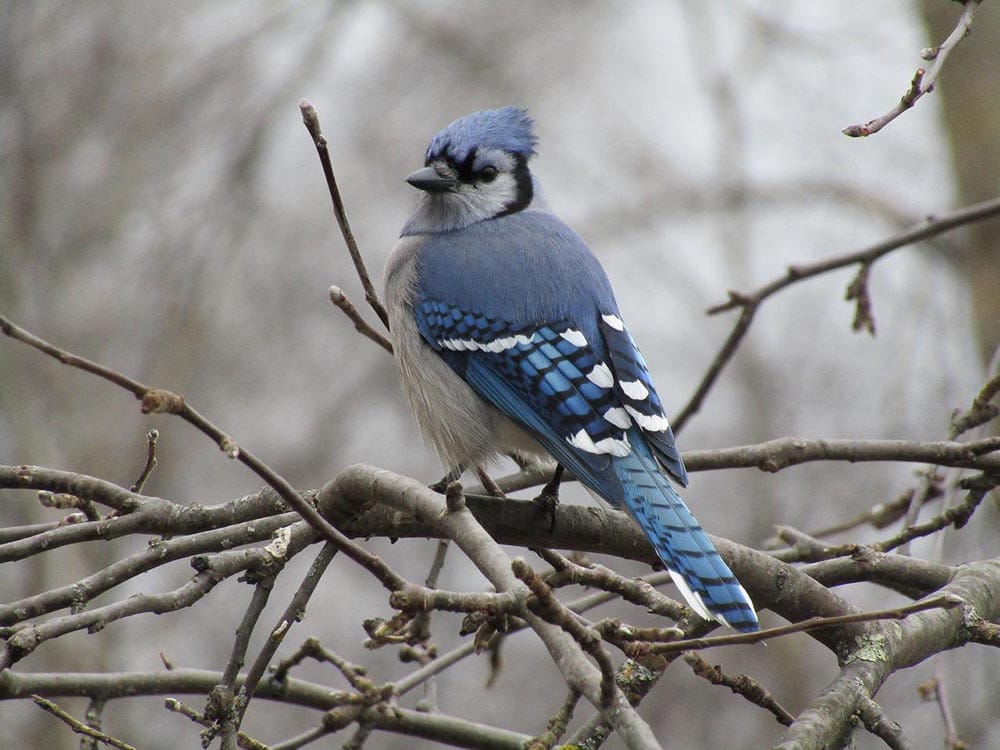
The Blue Jay is found throughout Central and Eastern North America, and while it does live in woodlands and forests, it is becoming an increasingly common sight in towns and cities as well as parks and fields. Below, we have included details of this recognizable bird’s habits and habitat, as well as some information to help you attract Blue Jays to your yard.

Quick Facts about Blue Jays
| Habitat: | Forests and Woodlands |
| Diet: | Omnivorous |
| Behavior: | Aggressive and Territorial |
| Nesting: | Outer branches of trees |
| Conservation: | Safe |
| Scientific name: | Cyanocitta cristata |
| Lifespan: | 7 years |
Blue Jay General Description
The Blue Jay is an intelligent songbird that is adaptable and forms close familial ties. They grow to around 10 inches but can grow slightly larger. They are blue on top with a white throat and chest. The crest of the head is a muted blue and the tail has black and white bars. Its feet and bill are black.
The bird has a distinctive call, but it also has a range of other sounds and songs and can imitate some birds in the wild.
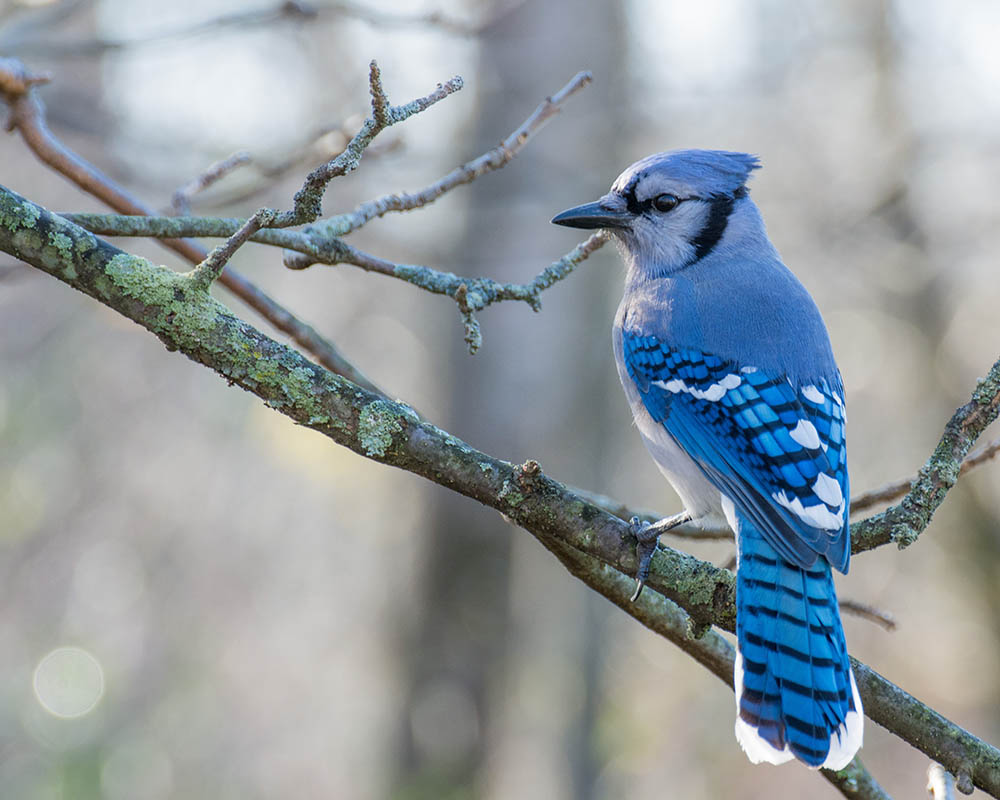
Blue Jay Range, Habitat, Behavior, Diet & Nesting
The Blue Jay is a highly adaptable and intelligent species, which means that it may be found in a wide variety of locales and settings.
Range
Blue Jays are found extensively in central and eastern areas of North America, but their range is expanding further to the Northwest. They do migrate south for the winter, although not all Blue Jays will migrate every year, so some can still be found at backyard feeders and in forests throughout the winter months.
Habitat
Although they do reside in forests and woodlands, Blue Jays prefer less densely wooded areas, so they will be more easily found at the edge of forests. They can also be found in parks and cities and built-up areas.
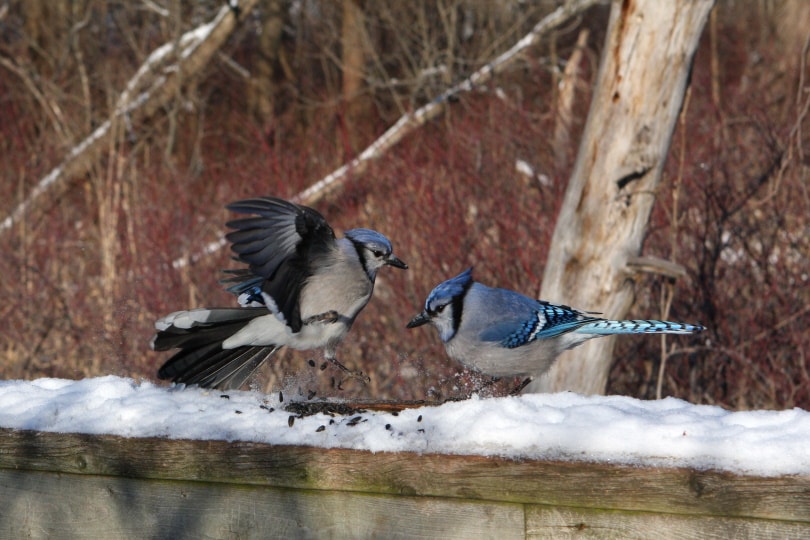
Behavior
The Blue Jay is a songbird and is named after the “jay” call it makes. However, this species can make hundreds of different sounds and can imitate some other bird calls. It typically only calls while perched and flies silently.
It is considered an aggressive bird, especially when defending its territory or young. A group of Blue Jays will attack predators and ward them off. While this is an effective defensive technique in the wild, it also means that they can monopolize backyard feeders to the detriment of other birds in the yard. They do raid nests of other birds and have been known to kill other birds as well.
Diet
Considered highly adaptable, the Blue Jay is omnivorous and will feed on almost anything to ensure it is well fed. This includes feeders, and this is one species that will almost indiscriminately eat whatever you put out.
Away from feeders, the majority of their diet is plant-based foods including nuts, seeds, and berries. They also eat a lot of insects like grasshoppers and beetles, as well as some larger animals including spiders, snails, small rodents, and frogs.
Nesting
When around the nest, Blue Jays tend to be quite quiet and industrious. However, if the nest is threatened, they will sound a very loud alarm. They nest in coniferous or deciduous trees, located up to 30 feet above the ground, and they line twig and grass-based nests with rootlets and moss. It is common to find items like string and paper inside the nest.
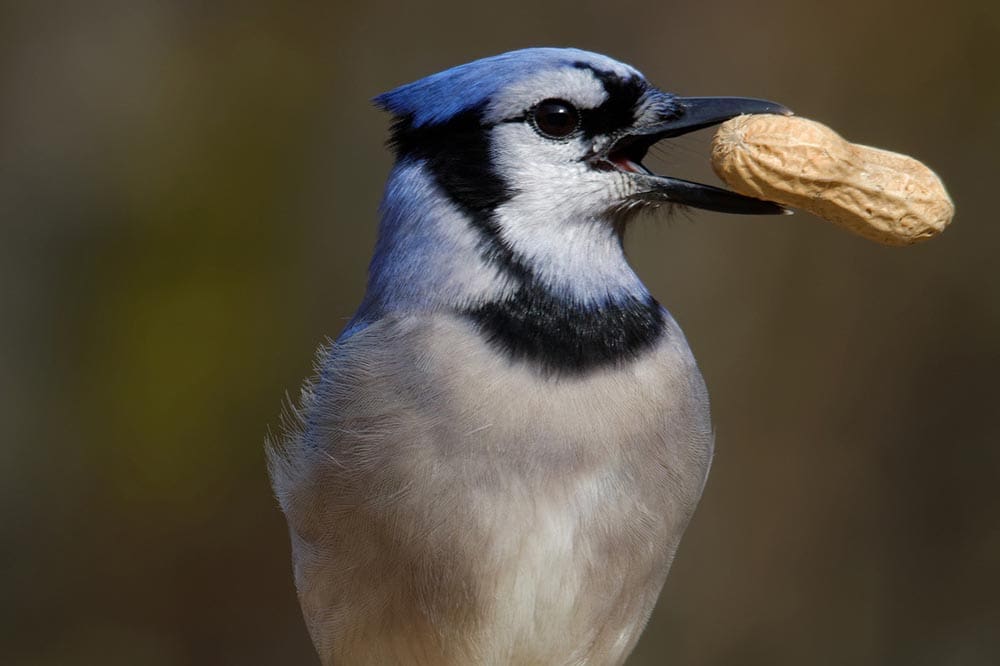
How to Find Blue Jays: Birdwatching Tips
Blue Jays are considered easy birds to spot because of their distinctive calls and appearance.
What to Listen For
Listen for the “jay” call, but bear in mind that the species can make other calls and will usually be quiet around its nest and when in flight. It makes the most noise while perched in trees.
What to Look For
In wooded areas, you are most likely to see the Blue Jay at the edge of the trees. Nests tend to be quite high and built in the nook of branches. The bird’s blue color and white belly, as well as its black and white bands, make it quite easy to identify with or without binoculars.
When to Look
Blue Jays build their nests between March and July—the mating and breeding seasons. Although some do migrate south during the cold months, not all do, so you may still be able to spot them during winter. When they do migrate, they tend to do so in flocks of thousands.
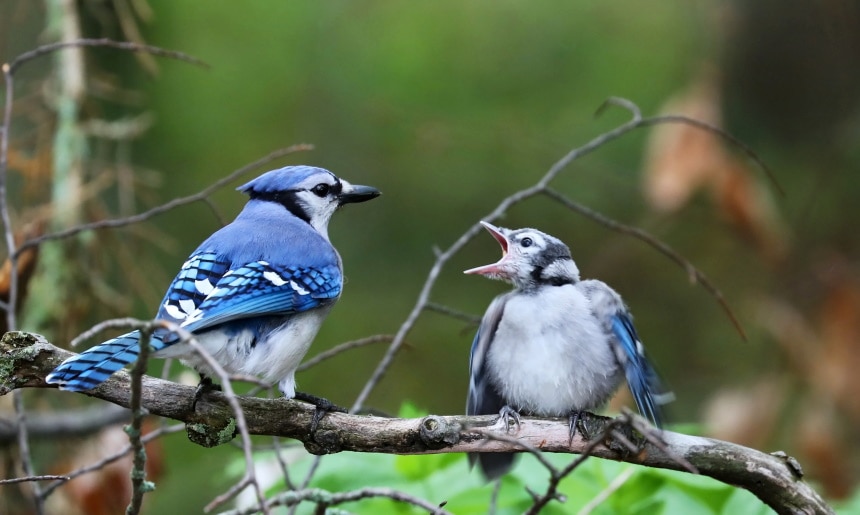
Attracting Blue Jays to Your Backyard: Tips & Tricks
If you want to attract Blue Jays to your yard, first remember that they can be aggressive, and they may put other birds off visiting. Otherwise, adapt your yard to suit this distinctive bird.
- Blue Jays will eat almost anything, but they are especially fond of nuts. Ensure they are roasted and unsalted and offer acorns, which they can easily crack with their strong bills.
- These jays need stability when feeding, so they are unlikely to use hanging feeders and often opt for platform feeders on poles.
- If you have large trees in or near your garden, you may be able to encourage Blue Jays to nest by providing them with nesting materials. Leave twigs around for them to use to build a secure home.
- This species may also be encouraged to use a birdbath. They prefer large baths and those that are free from potential hazards and predators.
- Although Blue Jays are adaptable and will take to feeders quite easily, they will be put off by human presence. Keep your distance, watch from a nearby window, and keep noise levels to a minimum if you want to keep from scaring them away.

Blue Jay Conservation: Is This Bird Threatened?
Blue Jays are not considered under threat. In fact, their range is spreading northwest, and the birds continue to adapt to life in towns and cities, as well as in parks, forests, and woodland.

Conclusion
The Blue Jay has a distinctive appearance and an equally recognizable call, although they also make a variety of other noises. It nests in trees, prefers to live on the outskirts of woodland and forests, and can be aggressive with other birds, especially if they encroach on their territory. Because they eat almost anything, as long as you put up stable platform feeders and offer a good-sized bird bath, there is a very good chance that you will be able to attract them to your garden.
Featured Image Credit: stevetricer, Pixabay
About the Author Robert Sparks
Robert’s obsession with all things optical started early in life, when his optician father would bring home prototypes for Robert to play with. Nowadays, Robert is dedicated to helping others find the right optics for their needs. His hobbies include astronomy, astrophysics, and model building. Originally from Newark, NJ, he resides in Santa Fe, New Mexico, where the nighttime skies are filled with glittering stars.
Related Articles:
10 Types of Hummingbirds in Arkansas (With Pictures)
8 Types of Hummingbirds in Nebraska (With Pictures)
5 Types of Hummingbirds in Idaho (With Pictures)
3 Types of Hummingbirds in Mississippi (With Pictures)
8 Types of Hummingbirds in Kansas (With Pictures)
5 Types of Hummingbirds in West Virginia (With Pictures)
5 Types of Hummingbirds in Ohio (With Pictures)
Where Do Nuthatches Nest? Nuthatch Nesting Habits Explained
